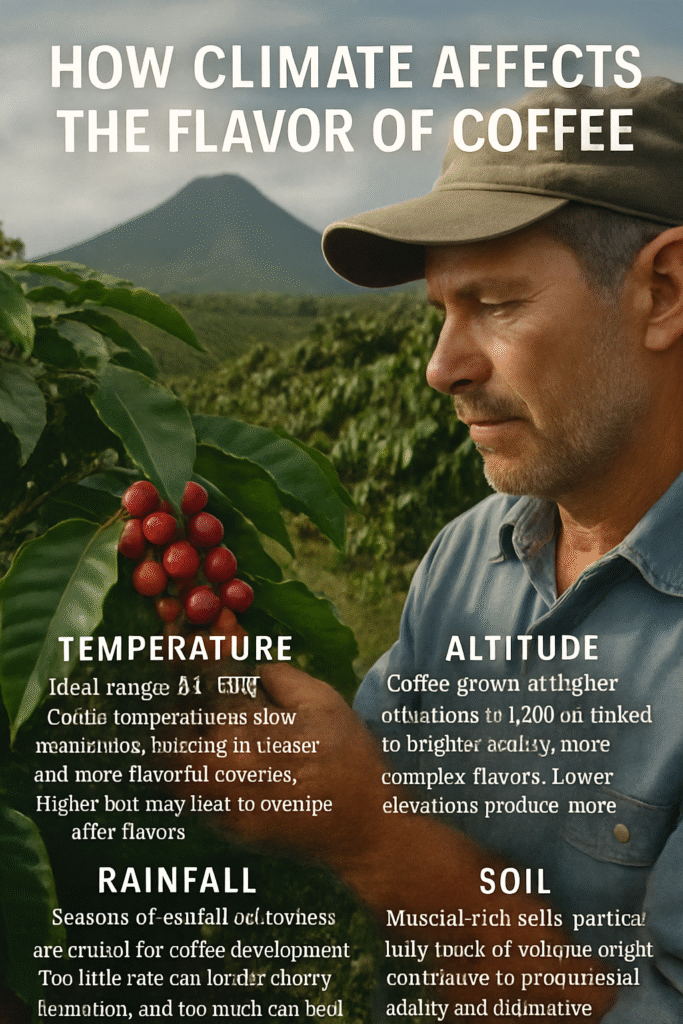When you sip a cup of coffee, you’re tasting more than just roasted beans—you’re tasting the climate where the coffee was grown. From temperature and rainfall to altitude and soil composition, environmental factors have a profound influence on the final flavor profile of your brew. Understanding how climate affects coffee can deepen your appreciation for this complex and beloved beverage.
The Concept of Terroir in Coffee
Borrowed from the wine industry, the term “terroir” refers to how a region’s climate, soil, and topography impact the taste of agricultural products. In coffee, terroir is everything:
- Temperature: Affects the speed at which coffee cherries mature.
- Rainfall: Influences flowering and fruit development.
- Sunlight: Helps in the sugar accumulation within the cherries.
- Soil Composition: Provides essential minerals that contribute to flavor nuances.
Together, these elements give each coffee its unique signature.
Temperature: The Sweet Spot for Coffee
Coffee plants, especially Arabica, thrive within a narrow temperature range:
- Ideal Range: 18°C to 23°C (64°F to 73°F).
If the temperature is too low, the cherries develop too slowly, sometimes leading to underdeveloped flavors. If it’s too high, they ripen too quickly, which can produce flat or bitter tastes.
Regions near the equator, like Ethiopia, Colombia, and Kenya, often provide the perfect stable climate for coffee cultivation.
Altitude: Higher Grounds, Brighter Flavors
Altitude has a direct effect on coffee flavor:
- Higher Altitudes (over 1,200 meters): Produce coffees with more acidity, floral notes, and complex flavors. The slow maturation of cherries at cooler, higher elevations allows for deeper sugar development.
- Lower Altitudes: Yield coffees that are typically more earthy, robust, and lower in acidity.
Examples:
- Ethiopian Yirgacheffe coffees (grown at high altitudes) are known for their vibrant citrus and floral notes.
- Brazilian coffees from lower elevations often feature chocolatey and nutty flavors.
Rainfall and Coffee Development
Coffee plants require a balance between rainy and dry seasons:
- Rainy Season: Stimulates flowering and fruit setting.
- Dry Season: Helps in ripening and harvesting.
Unpredictable rainfall due to climate change can cause stress to coffee plants, leading to inconsistent flavor profiles or reduced yields.
Sunlight and Bean Density
Adequate sunlight is crucial for photosynthesis, enabling plants to produce the sugars that impact the sweetness of the coffee. Shade-grown coffee, often found in traditional farming systems, can lead to beans that mature more slowly, resulting in higher density and richer flavors.
Too much direct sunlight without protection can stress the plants, making the beans less flavorful.
Soil Quality and Coffee Taste
Rich, volcanic soils—like those found in parts of Central America, Indonesia, and Africa—impart a distinctive mineral complexity to the coffee:
- Volcanic Soils: Enhance acidity and complexity.
- Sandy or Clay Soils: Might yield milder or less vibrant flavors.
Regions like Costa Rica’s Tarrazú or Guatemala’s Antigua are prized for the influence of their mineral-rich soils.
How Climate Change Is Affecting Coffee
Climate change poses significant threats to coffee production:
- Rising temperatures are pushing coffee cultivation to higher altitudes.
- Increased pests and diseases, like coffee leaf rust, are becoming more prevalent.
- Unpredictable weather patterns disrupt flowering and harvest cycles.
Many farmers are now adapting by experimenting with different coffee varieties, shade-grown techniques, and sustainable farming practices to combat the effects of a changing climate.
Final Thoughts: A Cup Shaped by the Environment
Every cup of coffee tells the story of its environment—the altitude where it grew, the rains that nourished it, the sun that ripened it, and the soil that grounded it. When you savor a truly special coffee, you’re experiencing the beautiful complexity that only nature, time, and careful cultivation can create.
Next time you enjoy a cup, think about the mountains, the rain, and the sunshine that helped craft that remarkable flavor in your hands.
